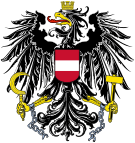Austrian Nazism
German National Socialist Workers' Party Deutsche Nationalsozialistische Arbeiterpartei | |
|---|---|
 | |
| Abbreviation | DNSAP |
| Landesinspekteur | |
| Landesleiter | Hermann Neubacher Josef Leopold[3][4] |
| Founders | Alfred Proksch[5]
... and others
|
| Founded | 5 May 1918 |
| Banned | 19 June 1933[6][7] |
| Preceded by | German Workers' Party[8] |
| Paramilitary wings | Austrian Legion |
| Membership | 34,000 (1923 est.)[9] |
| Ideology | Nazism[10][11] |
| Political position | Far-right |
| Electoral alliance | Christian National Congregation (1922)[15] |
| Colours | Brown |
| This article is part of a series on the |
| Politics of Austria |
|---|
 |
Austrian Nazism or Austrian National Socialism was a
Origins
Franko Stein from
Another convention was called in April 1902, under the title of "German-Political Workers' Association for Austria" (
DNSAP
At a party congress in Vienna in May 1918, the DAP changed its name to the Deutsche Nationalsozialistische Arbeiterpartei (DNSAP). It produced a National Socialist Program, which is thought to have influenced the later German Nazi manifesto.[citation needed] From 1920, the swastika was added as the party symbol. Before 1920, it consisted of a hammer, oak leaves and a quill.[17][18]
The Austrian DNSAP split into several factions in 1923 and again in 1926, the
According to fascism scholar
Leaders of the party, who were dubbed Landesleiter due to the recognition of Hitler as overall Führer, included Alfred Proksch (1931–33), Hermann Neubacher (1935) and Josef Leopold (1936–38), although real power frequently lay with Theodor Habicht, a German sent by Hitler to oversee Nazi activity in Austria.
Election results
| Date | Votes | Seats | Position | Size | |||
|---|---|---|---|---|---|---|---|
| No. | % | ± pp | No. | ± | |||
| 1930 | 111,627 | 3.03 | New | 0 / 165
|
New | Extra-parliamentary | 5th |
See also
- Nazi Party
- Austrian SS
- Austrofascism
- Austria within Nazi Germany
- Timeline of the Weimar Republic
- German Workers' Party (Austria-Hungary)
References
Notes
- ^ Miller & Schulz 2017, pp. 362–363.
- ^ Rees (1990), p.169
- ^ Rees (1990), p.229
- ISBN 978-0-8143-2055-6
- ^ Rees (1990), p.305
- Montreal Gazette, (June 20, 1933), p. 1.
- ^ Bukey 2002, p. 44.
- ISBN 978-87-635-0221-4
- ISBN 3-205-99400-0
- ^ Whiteside (1962), pp.1–3
- ISBN 978-0-87436-965-6
- ISBN 978-3-205-77337-5
- ISBN 9783205773375
- ^ David Nicholls. Adolf Hitler: A Biographical Companion. Chapel Hill: University of North Carolina Press, 2000. pp. 236–37.
- ^ Voithofer, Richard (2000) "Drum schliesst Euch frisch an Deutschland an …". Die Grossdeutsche Volkspartei in Salzburg 1920–1936 Böhlau, Wien/Köln/Weimar. pp.188–198
- ISBN 978-0-521-47501-3.
- ^ Jungcurt, Uta (2016) Alldeutscher Extremismus in der Weimarer Republik. Denken und Handeln einer einflussreichen Minderheit Berlin: De Gruyter. p.150
- ^ [https://arplan.org/2019/10/17/german-national-socialist-workers-party ("National Socialists Before Hitler, Part IV: The German National Socialist Workers’ Party (DNSAP)")
- ISBN 3-205-98714-4
- ^ aieou: http://www.aeiou.at/aeiou.encyclop.n/n122448.htm Nationalsozialismus
- ANNO)
- ^ "AUSTRIA: Eve of Renewal". Time. September 25, 1933. Archived from the original on July 2, 2011.
Bibliography
- Bukey, Evan Burr (2002). Hitler's Austria: Popular Sentiment in the Nazi Era, 1938–1945. ISBN 978-0-8078-5363-4.
- Miller, Michael D.; Schulz, Andreas (2017). Gauleiter : the regional leaders of the Nazi party and their deputies, 1925-1945. San Jose, Calif.: R.James Bender Publishing. ISBN 978-1-932970-21-0.
- ISBN 978-0-13-089301-7
- Whiteside, Andrew Gladding (1962) Austrian National Socialism Before 1918. The Hague: Martinus Nijhoff.
Further reading
- Pauley, Bruce F. (1981) Hitler and the Forgotten Nazis: A History of Austrian National Socialism. Chapel Hill, North CarolinaL ISBN 0-8078-1456-3
- Pauley, Bruce F. (1979). "From Splinter Party to Mass Movement: The Austrian Nazi Breakthrough". German Studies Review. 2 (1). German Studies Association: 7–29. JSTOR 1428703.


